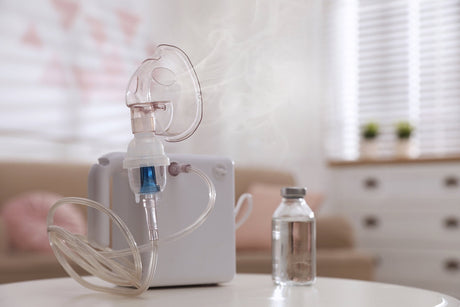For most patients, receiving the diagnosis can be overwhelming. There are a lot of new routines, lifestyle changes, and an information overload to adapt to. That is why ApriaHome strives to provide awareness on all aspects of diabetes and diabetes management for those living with the condition. Easily check your blood sugar levels at home with this step-by-step glucometer guide. Keep reading to uncover how to use & troubleshoot a glucose meter.
Self-testing your blood sugar (blood glucose) is a helpful tool for people with diabetes in monitoring their condition and avoiding complications. Keeping blood glucose levels within a normal range is crucial. Too little glucose in the blood might impair cognitive abilities. Conversely, glucose levels can do long-term damage or create complications if they become too high and stay high.
Testing blood sugar levels can contribute to the management of diabetes, and is useful for:
- Monitoring your blood sugar levels to see how effective diabetic treatment is
- Determining if your blood sugar is too high or too low
- Exploring the effects of food and exercise on blood sugar levels
- Learning how stress and sickness might impact your blood sugar levels
For most patients, receiving the diagnosis can be overwhelming. There are a lot of new routines, lifestyle changes, and an information overload to adapt to. That is why ApriaHome strives to provide awareness on all aspects of diabetes and diabetes management for those living with the condition. Easily check your blood sugar levels at home with this step-by-step glucometer guide. Keep reading to uncover how to use & troubleshoot a glucose meter.
What Is A Glucose Meter/ Blood Sugar Meter?
A blood glucose meter is used to monitor and display glucose meter readings for patients diagnosed with diabetes. Your blood glucose level is influenced by various factors, including exercise, diet, medication, stress, and more. A blood glucose meter or glucometer is an instrument for determining the amount of glucose in the blood by exposing a disposable test strip to a drop of blood and monitoring how the strip's electrical conductivity changes as a result of the chemical interaction between the glucose and the strip. Information is collected and data stored for monitoring, which helps patients meet their targets for A1C testing.
For most non-pregnant patients with diabetes, the American Diabetes Association recommends the following blood glucose level target range. A hemoglobin A1C (HbA1C) target will vary depending on age and health. These levels indicate the average blood sugar (glucose) levels monitored over two to three months.
According to the American Diabetes Association:
- 5.7% is considered normal
- 5.7%-6.4% indicates prediabetes
- 6.5%+ indicates type 2 diabetes
Your doctor will determine the frequency of your A1C tests, but it is recommended that you get tested at least twice a year to ensure that your therapy is effective. In addition, you may need to get your A1C checked more frequently if you aren't making progress toward your goals or if you make any changes to your treatment plan.
Monitoring blood glucose levels regularly will help patients reach their blood sugar goals.
Who Should Be Monitoring Sugar Levels With A Glucose Monitor?
This straightforward blood test reveals a wealth of information. The test results will show you what your blood sugar has been like on average during the last 2-3 months. Complications from diabetes become more likely as levels rise; this makes a glucometer essential for diabetic management.
Regular use of a glucometer may be necessary if you have the following:
- Diabetes type 1
- Diabetes type 2
- Adult-onset diabetes, or LADA (Latent autoimmune diabetes in adults)
- Gestational diabetes ‒ a form of diabetes that develops during pregnancy
How To Use A Blood Glucose Meter?
There are several types of meters, but the majority of them function in the same way. Request that your healthcare professional demonstrates the advantages of each and suitability for your requirements.
Ensure you have a friend or family member who can help you check your blood sugar levels using blood sugar monitoring devices in case you are unable to.
- Hands should be washed with soap and warm water and dried thoroughly.
- Close the test strip container securely after withdrawing a test strip. Tests exposed to moisture can get damaged.
- Massage your hand to allow blood to flow into your finger.
- Wipe down with an alcohol swab and prick your finger with a lancet.
- Squeeze a small quantity of blood onto the test strip.
- Insert the strip into the meter.
The reading will show in a few seconds. Record and track your results and note everything that may have caused the reading to fall outside your desired range, such as eating, exercise, stress, etc.
NB: Dispose of the lancet and strip safely, preferably wrapped up. Never share blood glucose monitoring equipment, such as lancets, with anybody.
Ideal Range For Blood Glucose Levels
The American Diabetes Association (ADA) provides the following basic guidelines for the blood sugar target range in adults with diabetes. Consult with your healthcare professional to determine your unique blood sugar targets, which should take into account your age, health, diabetes medication, and the particulars of your diagnosis.
The ADA for normal blood sugar targets are as follows:
- Before meals should read: 80 to 130 mg/dl
- 1 to 2 hours after meals should: read below 180 mg/dl
How To Troubleshoot Your Glucose Meter?
Blood sugar readers detect and display blood sugar levels accurately when used properly. Nevertheless, they are also subject to fault or failure and certain factors can affect glucose meter accuracy. If your glucometer seems inaccurate, take into account the following causes of meter inaccuracy and the solutions available to you.
Test Strip Failure:
- Remove and dispose of any test strips that have been damaged or expired.
- Maintaining a dry and cool environment for storing strips with humidity and moisture can make them ineffective.
- Ensure that the strips are compatible with your glucose meter.
Extreme Temperatures:
- Make sure your glucose meter and strips are always at room temperature.
Skin Contaminants:
- Before puncturing your skin, wash your hands and the testing area thoroughly with soap and water.
- Avoid using antiseptic hand rubs just before testing.
- If you've cleaned the area with alcohol wipes, ensure it's dry before testing.
Monitor Failure:
- The monitor should be replaced every 4 - 5 years.
- Ensure that the test strip is completely inserted into the reader.
- When the battery life of the monitor runs low, replace the batteries.
Insufficient Blood Drawn:
Place an adequate-sized drop of blood onto the test strip.After the initial drop of blood has been added to the test strip, no further blood should be added.
Testing Site:
- If you use a testing site other than your fingertip and believe the result is incorrect, test again using your fingertip.
- When the blood sugar level rapidly increases or declines, blood samples taken from other testing sites are less accurate than fingertip samples.
Low Red Cell Count:
- Your test findings may be less reliable if you are dehydrated or have a low red blood cell count (anemia).
Blood Sugar Testing Quality Control & Calibration
The majority of meters contain a quality control or calibration function. Test your meter regularly to verify that it accurately captures your blood glucose levels.
It's possible that certain glucose meters aren't the best option for you to use, given your diabetes subtype and testing routine. If your meter is damaged or gives consistently inaccurate readings, you should consider replacing or servicing it. Consult your doctor if you have any doubts about whether or not you are using the right meter.
Remember that you must verify that your blood sugar is under control before switching to an alternative meter. You can test the accuracy of your meter with the following:
Use A Testing Control Solution:
Troubleshoot your equipment by following your standard blood-testing process, but instead of blood, use a liquid control solution. These solutions are often included with your monitor and are accessible at most drugstores and pharmacies. It is good practice to use a testing control solution every time you open a new pack of testing strips.
Compare With Lab Results:
Bring the blood glucose monitor with you when you visit your doctor or have lab work done.
Check your blood sugar level with your meter while blood is being extracted for lab testing, making and comparing the readings. Results are deemed accurate if they are within 15% of the lab reading.
Tips For Using A Glucometer To Manage Diabetes
Tips for effective blood sugar monitoring:
- Always have your meter and equipment on hand, including lancets, testing strips, replacement batteries, alcohol swabs, etc.
- Keep track of testing strips, ensuring they aren't expired or exposed to moisture or extreme temperatures.
- Establish a daily routine for testing; some glucose monitors feature an alarm you can set for regular testing.
- Never assume your readings are correct; use the testing control solution and compare your readings with lab results, especially in the beginning.
- Log your results over time, and use a journal or app to keep track of your sugar levels to help you better manage your condition.
- Don't reuse lancets or strips; dispose of used equipment after testing.
- Don't use the same testing site for consecutive tests.
Blood Sugar Meter FAQ
How often should you calibrate the glucose meter?
Calibrate your glucometer sensor at least twice a day (every 12 hours), or whenever you get a calibration notification, to improve sensor accuracy.
How often should you replace your glucose meter?
High-end models can last up to 10 years, but on average, a monitor should be replaced every 4 - 5 years. If you've done comparative & control tests and your readings are very inaccurate, you should explore replacement options.
How do you reset a glucose meter?
One option is to press and hold the meter's reset button until the display screen flickers. Another alternative is to remove and replace the battery after 10 seconds.
How do you use the control solution for the glucose meter?
A control solution is a liquid with a fixed concentration of sugar contained. It can be obtained from your local pharmacy. To use a control solution for calibration:
- Place a test strip into the glucose meter.
- The control solution must then be touched to the test strip.
- The control solution's sugar level will then be displayed on the meter.
If the meter does not reflect the correct sugar level, it will need to be recalibrated.
Monitor, Test & Treat Diabetes With Apria Home
If you're newly diagnosed with diabetes, you may feel overwhelmed with all the information you've received and the changes you must make to your lifestyle. To learn more about your diagnosis, you can consult the ApriaHome guide to understanding diabetes.
Looking to buy or replace your glucose meter?
We've selected the finest range of blood glucose monitors and equipment from the world's best suppliers ‒ all available from the convenience of our online medical equipment portal.
Our top recommendations for the best blood glucose meter in terms of affordability, functionality, accessibility, and ease of use:
ApriaHome is passionate about restoring and enhancing the quality of life for diabetic patients across the country. Browse our range of diabetic testing, monitoring, and treatment solutions from the convenience of your own home.
Looking for something specific?
You can get in touch with our call center, and one of our helpful agents will be able to assist. Call now on (800) 780-1508 between 8:00 am - 10:00 pm EST daily.





